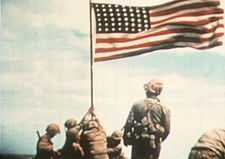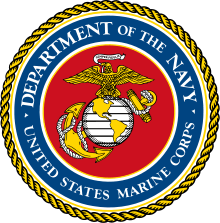2nd Battalion 28th Marines
| 2nd Battalion, 28th Marines | |
|---|---|
|
Movie Caption of 2/28 Marines after raising the flag atop Mount Suribachi | |
| Active |
February 1944 – January 1946 1967 - 1969 |
| Country | United States |
| Allegiance | United States of America |
| Branch | United States Marine Corps |
| Type | Infantry regiment |
| Role | Locate, close with and destroy the enemy with fire and maneuver |
| Size | 1,000 |
| Part of | Inactive |
| Engagements | |
The 2nd Battalion, 28th Marines (2/28) is an inactive infantry battalion of the United States Marine Corps. They were part of the 28th Marine Regiment and 5th Marine Division and fought during the Battle of Iwo Jima in World War II. Five of the battalion’s Marines and one Navy corpsman were immortalized in the famous photo of the flag raising on top of Mount Suribachi.
Subordinate units
- Headquarters Company
- Dog Company
- Easy Company
- Foxtrot Company
- Weapons Company
History
World War II
Early days

2nd Battalion, 28th Marines was activated at Marine Corps Base Camp Pendleton in February 1944 as part of the 5th Marine Division. Many of the battalion's personnel came from the recently deactivated 3rd and 4th Parachute Battalions.[1] In September of that year, they were sent to Hawaii to begin training for combat in the Pacific theater.
Battle of Iwo Jima
The battalion departed Hawaii in January 1945 and a month later were part of the initial invasion force in the Battle of Iwo Jima. 2/28 landed at Beach Green 1 just northeast of the imposing Mount Suribachi.[2] Their mission was part of the larger one for the 28th Marines, which was to assault across the island cutting it in two and then assault Mount Suribachi.[3] On D-Day+1, in a cold rain, 2/28 prepared to assault the mountain. The battalion's commanding officer, Lieutenant Colonel Chandler Johnson, set the tone for the morning as he deployed his tired troops forward: "It's going to be a hell of a day in a hell of a place to fight the damned war!"[4]
Early on the morning of February 23, 1945, four days after the initial landings, Captain Dave E. Severance, the commander of Company E, 2/28, ordered Lieutenant Harold G. Schrier to take a patrol and an American flag to the top of Suribachi. Staff Sergeant Louis R. Lowery, a Leatherneck Magazine photographer, accompanied the patrol. After a short fire fight, the 54"-by-28" flag was attached to a long piece of pipe, found at the crest of the mountain, and raised. This is the flag-raising which Lowery photographed. As the flag was thought to be too small to be seen from the beach below, another Marine from the battalion went on board LST 779 to obtain a larger flag. A second patrol then took this flag up to Suribachi's top and Joe Rosenthal, an Associated Press photographer, who had just come ashore, accompanied it.[4] It is the photo of the second flag raising that became the iconic photo of the battle.
Following the taking of Suribachi, 2/28 was allowed a few days rest and then returned to fighting on Iwo on March 2 until the island was declared secure on March 26, 1945.
Post Iwo Jima
After the fighting on Iwo Jima, the battalion returned to Camp Tarawa, Hawaii to rest and refit and begin training for the planned invasion of Japan. The Japanese surrender saw the battalion take part in occupation duty near the city of Nagasaki.[5] 2/28 returned to the United States in December 1945 and were deactivated shortly thereafter, in January 1946.[6]
Reactivation
The battalion was reactivated in 1967 to serve as a training unit for Marines going to and returning from Vietnam. It was deactivated again in 1969.
Medal of Honor recipients
See also
References
Notes
Books
- Rottman, Gordon L. (2002). U.S. Marine Corps World War II Order of Battle – Ground and Air Units in the Pacific War. Westport, Connecticut: Greenwood Press. ISBN 0-313-31906-5.
Web
- Alexander, Colonel Joseph H. (1994). "D-Day". CLOSING IN: Marines in the Seizure of Iwo Jima. Marine Corps Historical Center. Archived from the original on 11 January 2007. Retrieved 2007-01-01.
- Alexander, Colonel Joseph H. (1994). "Suribachi" (brochure). CLOSING IN: Marines in the Seizure of Iwo Jima. Marine Corps Historical Center. Archived from the original on 30 December 2006. Retrieved 2007-01-01.
External links
| |||||||||||||||||||||||||||||||||

